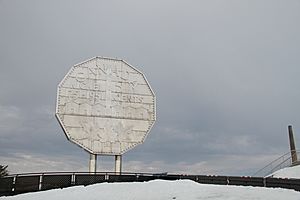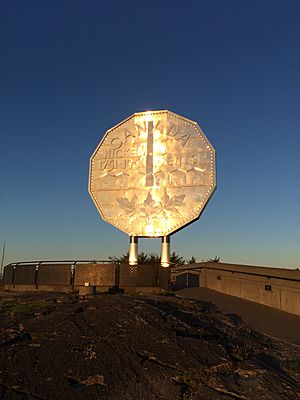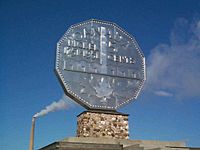Big Nickel facts for kids
Quick facts for kids Big Nickel |
|
|---|---|

The Big Nickel in March 2020, with the Superstack visible on the far right
|
|
| General information | |
| Location | Greater Sudbury, Ontario, Canada |
| Completed | 1964 |
| Height | 9 m (30 ft) |
| Design and construction | |
| Other designers | Bruno Cavallo |
The Big Nickel is a giant, nine-metre (30 ft) copy of a 1951 Canadian five-cent coin. It's located at the Dynamic Earth science museum in Greater Sudbury, Ontario, Canada. This huge coin is known as the world's largest coin!
The Big Nickel looks like a twelve-sided nickel. It sits on a small hill, giving it a great view of the area. In 2009, the Big Nickel celebrated its 45th birthday with a special party. They even showed off old coins from a collection at Science North.
Contents
How the Big Nickel Began
The idea for the Big Nickel started in 1963. A 28-year-old firefighter named Ted Szilva read about a contest. The contest asked people for ideas on how Sudbury should celebrate the upcoming Canadian Centennial.
Ted suggested building a huge coin, an underground mine, and a science center about mining. His idea was turned down at first. The committee felt it wasn't useful enough for the people of Sudbury.
But Ted believed in his dream. He started looking for the best spot to build his giant coin. On December 11, 1963, he bought some land for $1,000. This land was perfect because it was between Sudbury and Copper Cliff. From one side, you could see the INCO mining complex. From the other, you had a nice view of Sudbury city.
The city wouldn't give Ted a building permit or a road to his land. So, he got a lease for more land from INCO. This gave him access to his property. Eventually, he bought this leased land too. The Big Nickel was finally built just outside the city limits in Copper Cliff. This meant he didn't need a city building permit!
Raising Money for the Big Nickel
Ted Szilva needed money to make his dream happen. At first, some investors said they would help, but then they didn't. So, Ted ended up owning almost all of his company, Nickel Monument Development Ltd.
To raise money, Ted came up with a clever idea. He had special coins made that represented the monuments he wanted to build. He called his project the Canadian Centennial Numismatic Park. "Numismatic" means related to coins. The Big Nickel would be the main attraction. People from all over the world who loved coins bought these special medallions. This helped pay for the park's construction.
In 1964, people who bought these medallions received a package. It included three coins and a brochure about the park. The brochure talked about the park being "Canada's Most Unique Tourist Attraction."
Ted chose the 1951 five-cent coin for the Big Nickel. This design was created by artist Steve Trenka. The image on the coin shows a nickel refinery. Many people thought it looked like the INCO refinery in Sudbury. However, the 1951 refinery on the coin wasn't based on any real place.
The 1951 design was chosen for a special reason. It marked 200 years since a Swedish scientist, Baron Axel Frederic Cronstedt, first separated the element nickel. Before 1751, miners had trouble with this metal. They called it "Kupfernickel," or "Old Nick's Copper," because it was so hard to work with. Cronstedt proved it was a new element and named it nickel.
Ted Szilva wanted the Big Nickel to show where Sudbury's wealth came from. He wanted it to honor the people who mined and processed minerals in the Sudbury area. It was a symbol of Sudbury's pride for everyone to see.
Building the Giant Coin
Bruno Cavallo, a local artist, also had an idea for a giant coin. He joined forces with Ted Szilva to build the 1951 nickel. They decided to use stainless steel so it would last a long time in Sudbury's weather.
First, they projected the image of the 1951 five-cent coin onto a big wall. Ted and Bruno traced the image onto large paper. Then, Bruno used these tracings to shape many steel sheets. These pieces were then attached to a frame and joined together.
Jim Nemis's company, Noront Steel, helped build the Big Nickel's framework. Large stainless steel panels were made in Toronto and brought to the site. When finished, the Big Nickel was 30 feet (9 meters) tall and 2 feet (0.6 meters) thick.
Bruno Cavallo's company, Cavallo Signs, did all the artistic details. This included the head of King George VI, the numbers, the maple leaf, and the refinery image. All these parts were carefully attached to the stainless steel panels.
The base of the Big Nickel was 12 feet (3.7 meters) high and 5 feet (1.5 meters) thick. It was built using different rocks and minerals found in the Sudbury Basin. This showed where the wealth of the Sudbury area came from. In 1964, the Big Nickel cost about $35,000 to build.
The Big Opening
On July 27, 1964, the Canadian Centennial Numismatic Park officially opened. John Fisher, the Canadian Centennial commissioner, was there to unveil the Big Nickel. About 1,500 people came to watch! The event was covered by newspapers and TV. It was a big day for Ted Szilva and for Sudbury.
To make the park famous, Ted even had a float in the 1964 Grey Cup Parade. It featured a copy of the Big Nickel and a "Miss Big Nickel."
In 1965, an underground model mine was built at the park. Over 100,000 people visited it every year! This mine was also used for training students from Cambrian College. It was the first time a private company and a school worked together like this in Canada.
The park kept growing and adding new things. There were helicopter rides, a train, a carousel, and even a "moon module." The Big Nickel became a world-famous landmark.
The park also had other giant coin monuments. These included a $20 gold coin, a Kennedy half-dollar memorial, and a fantasy copper penny. There was also a Lincoln coin memorial. In 1975, a wampum monument was added. This symbolized the early money traded by Canada's Aboriginal peoples and European settlers.
The Big Nickel and Science North
In 1975, Ted Szilva wanted to create a world-class mining science center. His idea was rejected by the government because they didn't want to give money to private businesses.
But Ted didn't give up. In 1980, he convinced the Regional Municipality of Sudbury to develop a major tourist attraction. The government was willing to fund non-profit groups. So, Ted sold the Big Nickel to the Regional Municipality of Sudbury for $550,000. This led to the creation of the Sudbury Science Centre, which later became Science North.
The Big Nickel Today at Dynamic Earth
On January 22, 2001, the Big Nickel was taken down for repairs. After being fixed up, it was first placed at Science North. But then, on May 10, 2003, the Big Nickel was moved back to its original site. This site was redesigned and became the Dynamic Earth facility. The Big Nickel now stands proudly on a simple stand at Dynamic Earth.





